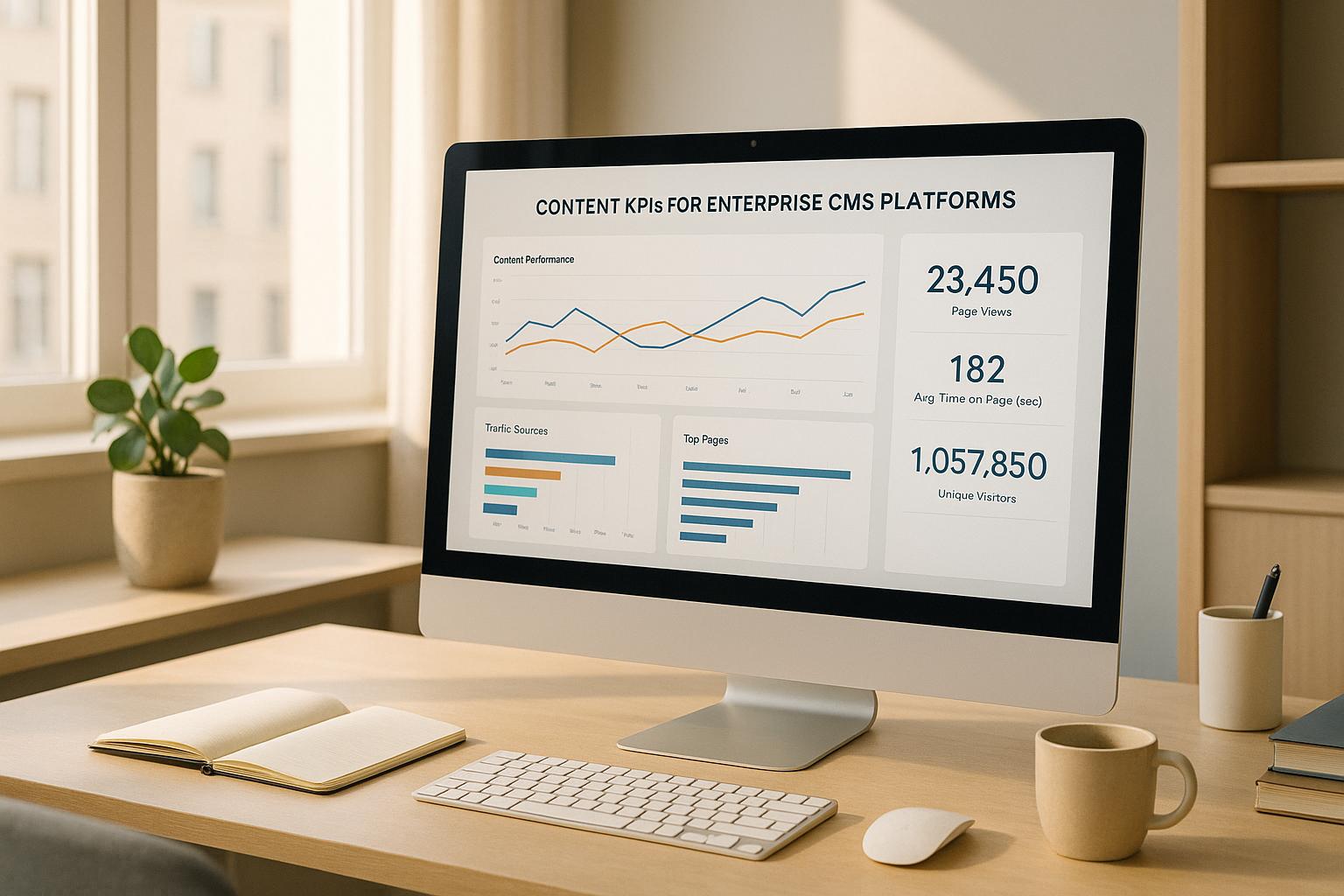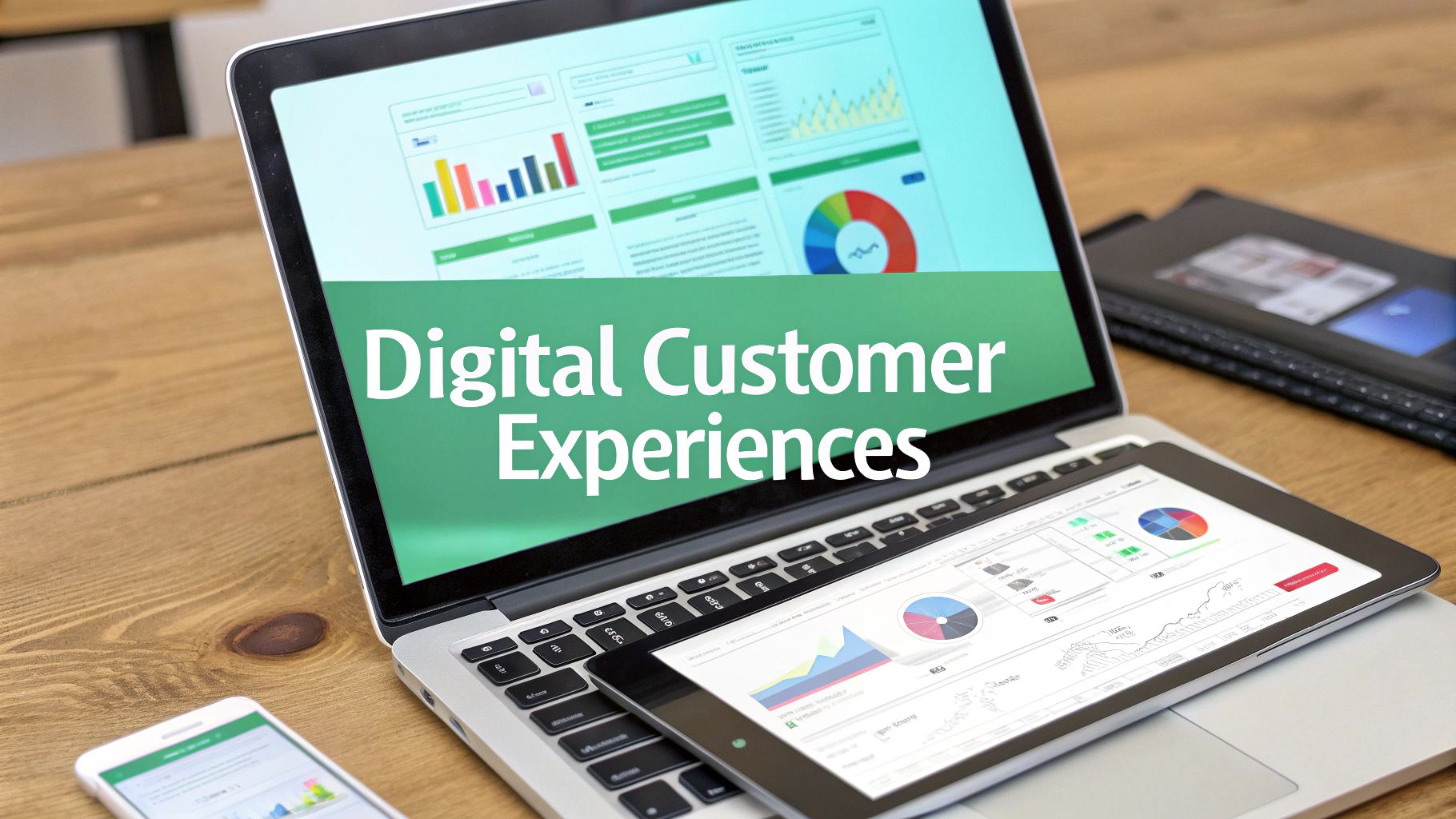Here’s the short answer: Content KPIs (Key Performance Indicators). These metrics help you track how well your content supports your business goals, especially when managing large-scale CMS platforms like Sitecore or Adobe Experience Manager.
Key Points at a Glance:
- Content Creation Metrics: Track how fast and efficiently content is produced (e.g., content velocity, time-to-publish).
- Performance Metrics: Focus on user behavior - session duration, bounce rates, and conversions.
- Search & Discovery Metrics: Measure how easily users find content (e.g., search success rate, keyword rankings).
- Process Efficiency Metrics: Analyze workflow bottlenecks, resource costs, and content maintenance needs.
Why it matters: These KPIs provide actionable insights to improve production workflows, boost user engagement, and align content with business outcomes.
Quick Example:
- Autoweb increased page views by 95% after upgrading its CMS.
- BioCentury boosted content engagement by 120% with better KPI tracking.
Tracking these metrics ensures your content strategy stays focused and delivers measurable results.
BGDXCP 5: An Intro to KPIs for Headless and Composable Architectures
Main Types of Content KPIs
Enterprise CMS platforms generate a wealth of data, but to make sense of it all, it helps to group these metrics into categories. Content KPIs generally fall into three main groups, each offering insights into a different aspect of your digital content strategy. Together, these categories cover content creation, performance, and discoverability, forming the backbone of an optimized digital content lifecycle.
Content Creation KPIs
These KPIs focus on how efficiently your content is produced. They can shed light on cost savings, faster delivery times, improved compliance, and better quality. Stacy Wolters, Chief Data & Analytics Officer and co-founder of Vodori, captures this well:
"Equally important are metrics that gauge the operational effectiveness of content production. After all, a more efficient marketing operation translates into serious cost savings, accelerated speed to market, elevated brand and regulatory compliance, and the holy grail of marketing - better content quality."
Metrics like content velocity and time-to-publish show how quickly ideas turn into live content. By tracking workflow duration, you can identify delays and refine processes. Monitoring contributor activity, such as the number of revisions, can highlight challenging topics or recurring issues. Similarly, keeping an eye on approver performance helps uncover bottlenecks in the review process. Together, these metrics provide a clear picture of how well your content production machine is running.
Content Performance KPIs
These metrics dive into how users interact with your published content. While basic numbers like page views and unique visitors give you a sense of traffic, deeper insights come from metrics like session duration and pages per session, which indicate how engaged users are.
Other metrics to watch include scroll depth (how far users read on a page) and click-through rates, which show how well your content drives actions like downloads, sign-ups, or inquiries. A high bounce rate can flag content that’s missing the mark, while an aggregated engagement rate - factoring in comments, shares, downloads, and time spent - offers a broader measure of effectiveness. Ultimately, conversion metrics tie all this back to business results, such as leads generated or sales attributed to your content.
Content Access and Search KPIs
In large-scale enterprise environments, where thousands of pages and documents live, ensuring content is easy to find is critical. This is where access and search KPIs come into play.
For example, the search success rate measures how often users find what they need via your site’s search function, while document retrieval time tracks how quickly specific content is accessed. Search query analysis can uncover gaps in your content or highlight what’s working well. Accessibility compliance metrics - like alt text for images, proper heading structures, and color contrast - ensure your site meets standards such as WCAG 2.1 AA. Metrics for mobile accessibility and content freshness further ensure a seamless and accurate user experience.
Key KPIs to Track on Enterprise CMS Platforms
When managing enterprise CMS platforms, keeping an eye on the right KPIs is essential. These metrics not only measure content performance but also provide actionable insights to fine-tune strategies for enterprise-level execution.
User Engagement and Conversion KPIs
Tracking how users interact with your content gives you a clear picture of what’s working and what isn’t:
- Average Session Duration: This tells you how long users stay on your site. Longer sessions mean your content is holding their attention and keeping them engaged.
- Pages per Session: A higher number here shows that users are navigating through your site effectively, likely discovering related content via internal links.
- Download Rates: Especially relevant for B2B enterprises, this KPI tracks how often users download resources like whitepapers or reports - critical for lead generation.
- Form Completion Rates: Measures how many users complete forms, whether for newsletter signups or contact requests. Low rates might point to poorly placed forms or unclear value propositions.
- Lead Attribution: This links content views to actual sales leads, helping justify the time and money spent on content creation.
Search and Content Discovery KPIs
How easily users can find what they need on your site is just as important as the content itself:
- Search Success Rate: This shows how effectively users can find what they’re looking for using your site’s internal search. For enterprises with large content libraries, this metric is crucial for ensuring a smooth user experience.
- Click-Through Rate (CTR): The percentage of users who click on your content from search results. With an average CTR of about 6.6% for search results, this metric helps you evaluate if your titles and descriptions are compelling enough.
- Keyword Rankings and Search Visibility: These metrics reveal how well your content performs in search engines, directly impacting traffic and user engagement.
- Average Content Retrieval Time: Tracks how quickly users can access specific pages or documents. Faster retrieval times improve both user satisfaction and productivity.
Process Efficiency KPIs
Operational efficiency is just as important as user engagement when it comes to sustaining a successful content strategy:
- Content Utilization Rate: Measures what percentage of your published content actually gets viewed. This can highlight underperforming pieces that may need a refresh - or even removal.
- Resource Cost per Content Piece: Tracks the total investment (time, money, tools) required to produce each piece of content. Keeping an eye on this helps you manage budgets and identify cost-saving opportunities.
- Content Lifecycle Efficiency: Shows how long your content remains relevant and continues driving traffic or conversions. Content with a longer lifecycle offers better returns over time.
- Workflow Completion Time: Measures how long it takes to move a piece of content from concept to publication. Shorter times often signal efficient processes and fewer bottlenecks.
- Content Maintenance Overhead: Tracks the time and resources spent on updating or fixing existing content. Lower overhead suggests a well-planned and sustainable content strategy.
| KPI Category | Key Advantage |
|---|---|
| User Engagement | Measures audience interest and content impact |
| Search & Discovery | Highlights content visibility and usability |
| Process Efficiency | Identifies cost and operational improvements |
As Professor Sunil Gupta from Harvard Business School puts it:
"It isn't enough to measure the final outcome alone. You also need to track intermediate metrics to understand where consumers might be getting stuck - essentially bottlenecks in the marketing funnel".
This holistic approach is especially valuable in enterprise CMS platforms, where content serves diverse purposes across various user journeys. By keeping tabs on these KPIs, enterprises can continually refine their strategies and workflows to align with broader business goals.
sbb-itb-91124b2
Setting Up Analytics and Reporting Tools
To effectively track KPIs, it's essential to configure analytics tools within your enterprise CMS. While platforms like Sitecore and Adobe Experience Manager come with built-in analytics features, their full potential is unlocked through proper setup and, when necessary, integration with third-party tools.
Sitecore offers built-in site and page performance analytics, which can be seamlessly integrated with your existing tech stack. This allows you to start monitoring basic content performance metrics right away without needing additional software.
Adobe Experience Manager, on the other hand, provides advanced reporting capabilities through Adobe Analytics. Although this requires an extra investment, it delivers in-depth insights, making it ideal for enterprises with complex content strategies.
When selecting analytics tools, prioritize those that process real-time data and present it in clear, easy-to-understand visualizations. Real-time reporting is especially valuable for time-sensitive decisions. Mehdi Oudjida, a digital analytics consultant, highlights the importance of a tailored approach:
"Real-time is not an exception when it comes to adhering to good principles. Like any measurement plan, it should be specific, reflecting the business, functional, or technical data requirements for the relevant digital device to follow. Providing a fixed view with basic dimensions and metrics is just a gadget. Getting access to relevant dimensions and metrics covering all standard fields is an excellent first step. It's also essential to have the freedom to design your real-time reports."
To ensure your analytics infrastructure is reliable, focus on data quality and consistency. Implement validation processes and regular quality checks to create a strong foundation for KPI dashboards.
How to Build KPI Dashboards
KPI dashboards are most effective when they align directly with your business objectives. Start by defining your goals, identifying key performance indicators, and using templates to simplify the dashboard creation process.
For Adobe Experience Manager, customizable dashboards allow you to consolidate data. These dashboards are user-specific, but you can save time and maintain consistency by sharing templates across your team. AEM also includes components for rendering SiteCatalyst data, giving you immediate access to important metrics.
To build a meaningful dashboard, follow these steps:
- Define your business objectives.
- Identify specific goals and the relevant performance indicators.
- Focus on the most critical metrics to avoid overwhelming users.
Each KPI should directly connect to a business goal, have baseline data for comparison, and be measurable over time. Avoid tracking vanity metrics that look impressive but provide little value.
Data integration and automation are key to maintaining accurate dashboards. Enterprises often pull data from multiple sources, such as sales systems, CRM platforms, ERP tools, and social media. Automating data updates ensures your dashboards remain current without requiring manual intervention.
Effective dashboard design also relies on visual clarity. Remove unnecessary elements, use whitespace wisely, and ensure labels are clear and accurate. Highlight key insights with bold text, larger fonts, or contrasting colors, and include interactive features like filters or tooltips to make the data more engaging. Accessibility is equally important - use colorblind-friendly palettes and add alternative text for screen readers.
Kogifi's Analytics Integration Services

Once your dashboards are set up, expert integration services can take your analytics capabilities to the next level. Enterprise CMS analytics often require specialized expertise to turn raw data into actionable insights. Kogifi's team has extensive experience with both Sitecore and Adobe Experience Manager, helping organizations go beyond basic reporting.
The process typically begins with a digital audit to evaluate your current analytics setup. This includes identifying gaps, optimizing data collection, and aligning analytics strategies with your business goals. From tracking code implementation to data flow optimization, every detail is addressed.
Kogifi also offers advanced traffic analysis, diving deeper than standard metrics like page views or session durations. Their analysis uncovers user behavior patterns, evaluates content performance across channels, and maps conversion paths. These insights directly inform content strategies and highlight optimization opportunities.
For businesses transitioning to a new platform or upgrading their CMS, Kogifi ensures that historical analytics data remains accessible and comparable. This continuity is crucial for tracking long-term trends and assessing the impact of platform changes on performance.
The company also provides 24/7 support, which is invaluable for resolving data collection issues that could affect decision-making. Quick access to technical expertise ensures data integrity is maintained at all times.
Kogifi’s approach prioritizes practical application over theoretical concepts. Their team collaborates with content creators, marketers, and executives to ensure analytics tools deliver insights that drive decisions - not just impressive visuals. They also offer training to empower your internal teams, ensuring you can manage and optimize your analytics setup for the long haul.
Using KPI Data to Improve Content Performance
Once you've measured your KPIs, the real value comes from using that data to refine and enhance your content strategy. KPI insights aren't just numbers - they're a roadmap for making smarter decisions. Platforms like Sitecore and Adobe Experience Manager make it easier to turn analytics into actionable steps, enabling you to test, tweak, and optimize your content in real-time.
One of the most effective ways to act on KPI data is through targeted content testing and optimization.
Content Testing and Optimization
A/B testing is a practical way to transform your KPI insights into measurable results. By comparing different versions of your content, you can move beyond guesswork and base decisions on hard data. Modern tools, especially those powered by AI, take this a step further by automating the process - making hypothesis creation and testing faster and more precise.
Take this example: SuperAGI partnered with an online fashion retailer to increase conversions by 37% in just six weeks. They used AI-powered A/B testing to refine product pages, checkout flows, and personalized recommendations. By analyzing user behavior, the AI adjusted layouts, smoothed out checkout processes, and tailored recommendations. The result? A 25% drop in cart abandonment and a 15% boost in order value.
AI also shines in multi-variable testing, where it evaluates several elements - like headlines, images, and call-to-action buttons - all at once to find the best-performing combinations. For instance, Build with Ferguson saw an 89% increase in purchases from recommendations by testing different strategies. Customers who engaged with these recommendations spent 13% more and, on average, bought 2.4 additional items.
To make A/B testing work for you, start by setting clear goals and collecting enough data to ensure accurate results. While AI can handle much of the heavy lifting, human oversight is vital to keep these optimizations aligned with your broader business objectives.
Personalization and Multi-Channel Strategy
KPI data isn't just for testing - it’s also the key to delivering personalized, cross-channel experiences. AI-driven personalization adapts content based on user behavior and preferences, a tactic that’s quickly becoming a cornerstone of enterprise content strategies. In fact, 77% of marketers plan to increase their investment in personalization over the next two years.
Combining A/B testing with AI personalization can lead to impressive outcomes. For example, HubSpot used AI to personalize its onboarding process, reducing churn by 30% through targeted workflows and tailored content recommendations. Similarly, ZoomInfo optimized its free trial experience with AI-powered testing, achieving a 25% increase in conversions from free trial to paid subscriptions, while also reducing support inquiries and improving user satisfaction.
For businesses with an omnichannel approach, KPI data helps identify which platforms work best for specific audiences and content types. This allows you to allocate resources more effectively and fine-tune your content distribution. Metrics like Customer Lifetime Value (CLV), Customer Acquisition Cost (CAC), Multi-Channel Engagement Rate, and Cross-Channel Customer Journey Analytics provide valuable insights. For example, The New York Times boosted digital revenue by 15% by refining its content and ad strategies across multiple platforms, while the BBC saw a 20% surge in user engagement after using AI to personalize content recommendations.
Companies like Kogifi specialize in turning these insights into action. With expertise in platforms like Sitecore and Adobe Experience Manager, they help organizations implement AI-driven personalization and omnichannel strategies. By translating KPI data into actionable rules, they ensure your content delivers maximum value and impact.
Conclusion
Tracking content KPIs is essential for making informed decisions and achieving measurable business outcomes. Without proper monitoring, organizations risk losing focus and direction. Consider this: 41% of businesses fail to track internal content views, 60% operate without a long-term communications strategy, and companies with 10,000 intranet users can face productivity losses of up to $15 million annually.
Draven McConville highlights the importance of a robust CMS:
"A CMS is the bedrock of any online business. Having the right one doesn't just help organize your content, it empowers your team to move faster, maintain consistency, and focus on creating value rather than managing files. For startups especially, this efficiency can be the difference between scaling smoothly and getting bogged down in operational chaos."
To truly benefit from content KPIs, organizations must commit to consistent monitoring and strategic refinement. Regularly reviewing both leading and lagging KPIs allows businesses to adapt quickly to changes and seize opportunities for improvement. This proactive approach not only drives immediate results but also lays the groundwork for sustained growth.
FAQs
How can I measure the success of my content strategy using an enterprise CMS platform?
To gauge how well your content strategy is performing with an enterprise CMS like Sitecore or Adobe Experience Manager, start by setting specific KPIs that match your business objectives. These might include metrics like engagement rates, conversion rates, or the overall reach of your content.
Take advantage of the analytics and reporting tools built into your CMS to monitor these metrics and spot trends. Regularly reviewing this data helps you pinpoint what’s working and what might need tweaking. Keeping a close eye on performance ensures your content efforts align with larger goals, such as boosting revenue, enhancing customer retention, or building stronger brand recognition.
By focusing on actionable insights, you can ensure your content strategy delivers measurable results that align with your business priorities.
What is the difference between content creation KPIs and content performance KPIs, and how should you prioritize them?
Content creation KPIs help you track how effectively and efficiently your team is producing content. These metrics might include the number of articles published, how much time is spent creating content, and whether you're sticking to your editorial calendar. On the flip side, content performance KPIs focus on how your audience interacts with your content and how well it supports your business goals. Think page views, engagement rates, conversion rates, or even SEO rankings.
To make the most of these metrics, tie them directly to your business goals. For example, if your main focus is building brand awareness, prioritize performance KPIs like reach and engagement. But if streamlining your production process is the goal, give more attention to creation KPIs. Striking a balance between the two ensures you're not only creating content efficiently but also delivering results that matter.
How can AI-driven personalization and A/B testing improve content performance on enterprise CMS platforms?
AI-powered personalization takes content to the next level by tailoring it to match each user's unique preferences. This makes the content not only more engaging but also more relevant, which naturally boosts user satisfaction. As a result, key metrics like engagement rates and time spent on site see noticeable improvements.
When it comes to A/B testing, AI steps in to make the process faster and more precise. By analyzing performance data in real-time, it pinpoints which content variations perform best. This means marketers can fine-tune their strategies to drive better conversion rates and maximize ROI. Together, these tools enable smarter, data-driven decisions, ensuring your content strategy aligns with both user expectations and business objectives.








































